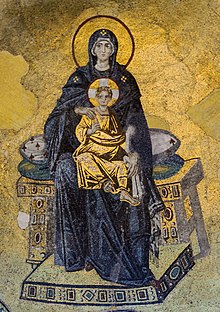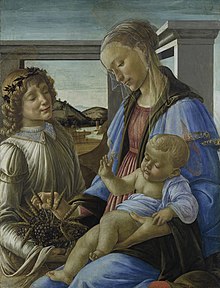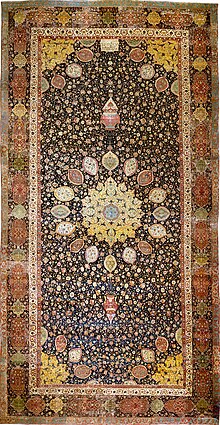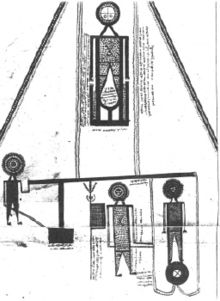Religious art

Religious artis a visual representation of religious ideologies and their relationship with humans. Sacred art directly relates to religious art in the sense that its purpose is forworshipand religious practices. According to one set of definitions,artworksthat are inspired byreligionbut are not considered traditionallysacredremain under the umbrella term of religious art, but not sacred art.[1]
Other terms often used for art of various religions arecult image,usually for the main image in aplace of worship,iconin its more general sense (not restricted toEastern Orthodoximages), and "devotional image" usually meaning a smaller image for private prayer or worship. Images can often be divided into "iconic images", just showing one or more figures, and "narrative images" showing moments from an episode or story involving sacred figures.
The use of images has been controversial in many religions. The term for such opposition isaniconism,withiconoclasmbeing the deliberate destruction of images by people of the same religion.
Buddhist art[edit]
This sectionneeds additional citations forverification.(June 2015) |

Buddhist art originated on theIndian subcontinentfollowing the historical life ofSiddhartha Gautama,6th to 5th century BC, and thereafter evolved by contact with other cultures as it spread throughout Asia and the world.
Buddhist art followed believers as the dharma spread, adapted, and evolved in each new host country. It developed to the north throughCentral Asiaand intoEastern Asiato form the Northern branch of Buddhist art.
Buddhist art followed to the east as far asSoutheast Asiato form the Southern branch of Buddhist art.

In India, the Buddhist art flourished and even influenced the development ofHindu art,until Buddhism nearly disappeared in India around the 10th century due in part to the vigorous expansion ofIslamalongsideHinduism.
Tibetan Buddhist art[edit]
Most Tibetan Buddhist artforms are related to the practice ofVajrayanaor Buddhist tantra. Tibetan artincludesthangkasandmandalas,often including depictions ofBuddhasandbodhisattvas.Creation of Buddhist art is usually done as ameditationas well as creating an object as aid to meditation. An example of this is the creation of asand mandalaby monks; before and after the construction prayers are recited, and the form of the mandala represents the pure surroundings (palace) of a Buddha on which is meditated to train the mind. The work is rarely, if ever, signed by the artist. Other Tibetan Buddhist art includes metal ritual objects, such as thevajraand thephurba.
Indian Buddhist art[edit]
Two places suggest more vividly than any others the vitality of Buddhist cave painting from about the 5th century AD. One is Ajanta, a site in India long forgotten until discovered in 1817. The other is Dunhuang, one of the great oasis staging posts on the Silk Road...The paintings range from calm devotional images of the Buddha to lively and crowded scenes, often featuring the seductively full-breasted and narrow-waisted women more familiar in Indian sculpture than in painting.[2]
Chinese Buddhist art[edit]
Christian art[edit]
Christian sacred art is produced in an attempt to illustrate, supplement and portray in tangible form the principles ofChristianity,though other definitions are possible. It is to make imagery of the different beliefs in the world and what it looks like. Most Christian groups use or have used art to some extent, although some have had strong objections to some forms of religious image, and there have been major periods oficonoclasmwithin Christianity.
Most Christian art is allusive, or built aroundthemesfamiliar to the intended observer. Images ofJesusand narrative scenes from theLife of Christare the most common subjects, especially the images ofChriston theCross.
Scenes from theOld Testamentplay a part in the art of most Christian denominations. Images of theVirgin Mary,holding theinfant Jesus,and images of saints are much rarer in Protestant art than that ofRoman CatholicismandEastern Orthodoxy.
For the benefit of the illiterate, an elaborateiconographicsystem developed to conclusively identify scenes. For example,Saint Agnesdepicted with a lamb,Saint Peterwith keys,Saint Patrickwith a shamrock. Each saint holds or is associated with attributes and symbols in sacred art.
History[edit]

Early Christian artsurvives from dates near the origins of Christianity. The oldest surviving Christian paintings are from the site atMegiddo,dated to around the year 70, and the oldest Christian sculptures are fromsarcophagi,dating to the beginning of the 2nd century. Until theadoption of Christianity by ConstantineChristian art derived its style and much of itsiconographyfrom popularRoman art,but from this point grand Christian buildings built under imperial patronage brought a need for Christian versions of Roman elite and official art, of whichmosaicsin churches in Rome are the most prominent surviving examples. Christian art would soon become the foundation of churches across Europe. Stained glass windows often depict biblical scenes to be reflected across the inner workings of the building. Murals and altarpiece art also fill churches with intricate and expressive Christian images.
During the development of early Christian art in theByzantine empire(seeByzantine art), a more abstract aesthetic replaced the naturalism previously established inHellenisticart. This new style was hieratic, meaning its primary purpose was to convey religious meaning rather than accurately render objects and people. Realistic perspective, proportions, light and colour were ignored in favour of geometric simplification of forms, reverse perspective and standardized conventions to portray individuals and events. The controversy over the use ofgraven images,the interpretation of the Second Commandment, and the crisis ofByzantine Iconoclasmled to a standardization of religious imagery within theEastern Orthodoxy.

The Renaissance saw an increase in monumental secular works, but until theProtestant ReformationChristian art continued to be produced in great quantities, both for churches and clergy and for the laity. During this time,Michelangelo Buonarrotipainted theSistine Chapeland carved the famousPietà,Gianlorenzo Berninicreated the massive columns inSt. Peter's Basilica,andLeonardo da Vincipainted theLast Supper.The Reformation had ahuge effect on Christian art,rapidly bringing the production of public Christian art to a virtual halt in Protestant countries, and causing the destruction of most of the art that already existed.
As a secular, non-sectarian, universal notion of art arose in 19th-century Western Europe, secular artists occasionally treated Christian themes (Bouguereau,Manet). Only rarely was a Christian artist included in the historical canon (such asRouaultorStanley Spencer). However many modern artists such asEric Gill,Marc Chagall,Henri Matisse,Jacob Epstein,Elisabeth FrinkandGraham Sutherlandhave produced well-known works of art for churches.[3]Through a social interpretation of Christianity,Fritz von Uhdealso revived the interest in sacred art, through the depiction of Jesus in ordinary places in life.
Since the advent of printing, the sale of reproductions of pious works has been a major element of popular Christian culture. In the 19th century, this included genre painters such asMihály Munkácsy.The invention of color lithography led to broad circulation ofholy cards.In the modern era, companies specializing in modern commercial Christian artists such asThomas BlackshearandThomas Kinkade,although widely regarded in the fine art world askitsch,[4]have been very successful.
The last part of the 20th and the first part of the 21st century have seen a focused effort by artists who claim faith in Christ to re-establish art with themes that revolve around faith, Christ, God, the Church, the Bible and other classic Christian themes as worthy of respect by the secular art world. Art could then be used to cultivate the church to participate in Christianity once again. Artists such asMakoto Fujimurahave had significant influence both in sacred and secular arts. Other notable artists includeLarry D. Alexander,Gary P. Bergel, Carlos Cazares, Bruce Herman, Deborah Sokolove, andJohn August Swanson.[5]
Confucian art[edit]

Confucian art is inspired byConfucianism,coined after theChinese philosopherand politicianConfucius.Confucian art originated inChina,then spread westwards on theSilk Road,southward down tosouthern Chinaand then ontoSoutheast Asia,and eastwards throughnorthern Chinaon toJapanandKorea.While it still maintains a strong influence within Indonesia, Confucian influence on western art has been limited. While Confucian themes enjoyed representation in Chinese art centers, they are fewer in comparison to the number of artworks that are about or influenced byDaoismandBuddhism.[6]
History[edit]
Prior to theHan dynasty,the Chinese art hierarchy consideredmusicas the highest form of art and dismissedcalligraphy,poetry,andpaintingas art forms and craft practiced by the lower class. Nevertheless, poetry was also popular during Confucius's time, and poetry was both praised and ranked high in status with music. According to Confucius and his disciples, music strives to create and reflect harmony in the world; hence, education should begin with the foundations of poetry and moral behavior, and conclude with music.[7][8]Over time, the development of theChinese writing systempromoted the growth of calligraphy and visual arts in terms of social status. Confucian aesthetics and values further contributed to the development of these visual art forms, withlandscape paintingsand calligraphy works centralizing on the written works and teachings of Confucianism.[7]
Hindu art[edit]

This sectionneeds expansion.You can help byadding to it.(December 2023) |
Hinduism,with its1 billion followers,it makes up about 15% of the world's population and as such the culture that ensues it is full of different aspects of life that are effected by art. There are 64 traditional arts that are followed that start with the classics of music and range all the way to the application and adornment of jewellery. Since religion and culture are inseparable with Hinduism recurring symbols such as the gods and their reincarnations, thelotusflower, extra limbs, and even the traditional arts make their appearances in many sculptures, paintings, music, and dance.
Islamic art[edit]

A prohibition against depicting representational images in religious art, as well as the naturally decorative nature of Arabic script, led to the use of calligraphic decorations, which usually involved repeating geometrical patterns and vegetal forms (arabesques) that expressed ideals of order and nature. These were used on religious architecture, carpets, and handwritten documents.[9]Islamic art has reflected this balanced, harmonious world-view. It focuses on spiritual essence rather than physical form.
While there has been an aversion to potential idol worship through Islamic history, this is a distinctly modernSunniview.Persian miniatures,along with medievaldepictions of Muhammadandangels in Islam,stand as prominent examples contrary to the modern Sunni tradition. Also,Shi'aMuslims are much less averse to the depiction of figures, including the Prophet's as long as the depiction is respectful.
Figure representation[edit]
The Islamic resistance to the representation of living beings ultimately stems from the belief that the creation of living forms is unique to God. It is for this reason that the role of images and image makers has been controversial.
The strongest statements on the subject of figural depiction are made in theHadith(Traditions of the Prophet), where painters are challenged to "breathe life" into their creations and threatened with punishment on the Day of Judgment.

The Qur'an is less specific but condemns idolatry and uses the Arabic term musawwir ( "maker of forms", or artist) as an epithet for God. Partially as a result of this religious sentiment, figures in painting were often stylized and, in some cases, the destruction of figurative artworks occurred.Iconoclasmwas previously known in the Byzantine period and aniconicism was a feature of the Judaic world, thus placing the Islamic objection to figurative representations within a larger context. As ornament, however, figures were largely devoid of any larger significance and perhaps therefore posed less challenge.[10] As with other forms of Islamic ornamentation, artists freely adapted and stylized basic human and animal forms, giving rise to a great variety of figural-based designs.
Arabesque[edit]
Arabesque is a decorative art style characterized by repetitive, intricate patterns of intertwined plants and abstract curvilinear motifs.[11] It is believed to have originated in the Islamic world, and its use spread throughout the Middle East, Europe, and North Africa. It has played an important role in Islamic art, often serving as a form of religious expression. The term "arabesque" is a French term derived from the Italian word arabesco, meaning "in the Arabic style"[12] Arabesque patterns can be found in various media, including ceramics, architecture, calligraphy, and textiles. Since the 19th century, Arabesque art has been highly influential in Western art and design, with many designers and artists incorporating patterns into their work.
Calligraphy[edit]
Calligraphy is a highly regarded element of Islamic art. TheQur'anwas transmitted in Arabic, and inherent within the Arabic script is the potential for ornamental forms. The employment of calligraphy as ornament had a definite aesthetic appeal but often also included an underlyingtalismaniccomponent. While most works of art had legible inscriptions, not all Muslims would have been able to read them. One should always keep in mind, however, that calligraphy is principally a means to transmit a text, albeit in a decorative form.[13] From its simple and primitive early examples of the 5th and 6th century AD, the Arabic alphabet developed rapidly after the rise of Islam in the 7th century into a beautiful form of art. The main two families of calligraphic styles were the dry styles, called generally theKufic,and the soft cursive styles, which includeNaskhi,Thuluth,Nastaliqandmany others.[14]
Geometry[edit]
Geometric patterns make up one of the three non-figural types of decoration in Islamic art.[15]Whether isolated or used in combination with non-figural ornamentation or figural representation, geometric patterns are popularly associated with Islamic art, largely due to their aniconic quality.[15]These abstract designs not only adorn the surfaces of monumental Islamic architecture but also function as the major decorative element on a vast array of objects of all types.[16]
Types Of Geometric Styles
Geometric patternsare frequently associated with Islamic art, partly because of their iconic appeal, whether used alone or in conjunction with figural depiction or non-configurable adornment.[17]Theseabstract patternsare used as the primary ornamental feature on various items of all kinds, in addition to adorning the surfaces of massive Islamic buildings.[17]Although geometric ornamentation may have peaked in the Islamic world, the Greeks, Romans and Sasanians in Iran were the sources for geometric shapes and elaborate patterns.[18]Islamic artistsincorporated significant components of the classical past to invent a new form of decoration that highlighted the vitality of order and unity. Islamic astronomers, mathematicians and scientists contributed these forms, which were crucial for their type of art style.[18]
History And Design
Geometric shapes resemble the arabesque design found in many vegetal designs in terms of its abstraction, repeated motifs and symmetry. Geometric designs frequently coexist withcalligraphicdecoration.[19]Circles and interlaced circles, squares or four-sided polygons are the typical star pattern resulting from squares and triangles inscribed in a circle.[19]Multi-sided polygons are the four fundamental shapes or “repeat units” from which the more complex patterns are built.[19]It is evident, however, that the intricate designs found on several things come in various sizes and configurations, making them suitable for inclusion more than category.
The geometric shape of the circle is used in Islamic art to signify the fundamental symbol of oneness and the ultimate course of all diversity in creation.[20]As the illustration below shows, many classic Islamic patterns have ritual beginnings in the circle's raw partition into regular sections.
Four circle divisions resulted in the above pattern, created inYazd, Iran,in the fifteenth century.[21]From there, a regular grid of triangles is created, and then the design is added on top of it. See how the intricate pattern intertwines with the fundamental design, shown in the images above as a white outline.[21]
Alhambra Palace Geometry
Geometric patterns, biomorphic design(arabesque)and calligraphy are expertly combined in the Alhambra in Spain from the 14th century.[21]Islamic art is made up of these three separate but complementary fields. They are arranged in a three-tiered hierarchy, with geometry at the button.[21]This is frequently indicated by its use on the lower portions of walls or floors, as in the example above.
The decorative features used use a variety of symmetries that are now recognized as belonging to separate mathematical groups, yet the patterns’ delicacy and elegance are unmatched in contemporary mathematical thought.[22]Although it was once customary in Islam to use geometric shapes, these designs are works of architecture.[22]Since the eighth century,Muslim calligraphersand geometric pattern designers have decorated mosques, castles and manuscripts.[22]Most often, Islamic geometric designs are employed in places of worship as a way to exaltGod.Grand structures made by divine geometry include buildings, gardens and floors.[23] The Blue Mosque Geometry
There are observable patterns spanning a thousand years of Islamic history and throughout the entire Islamic world since these geometric patterns are also connected toIslamic culture.[22]In some pieces of architecture, Islamic architects follow the same guidelines, such as in theBlue Mosqueand theAlhambrain Granada pictured above. The Alhambra palace in Spain and the Samarkand mosque in Uzbekistan are just two examples of the art of repeated geometric designs that can be seen worldwide.[24]
Jain art[edit]
Jain art refers to religious works of art associated withJainism.Even though Jainism spread only in some parts of India, it has made a significant contribution toIndian artand architecture.[25]
Mandaean art[edit]

Mandaeanart can be found in illustrated manuscript scrolls calleddiwan.Mandaean scroll illustrations, usually labeled with lengthy written explanations, typically contain abstract geometric drawings ofuthrasthat are reminiscent ofcubismorprehistoric rock art.[26]
Sikh art[edit]
The art, culture, identity, and societies of theSikhshas been merged with different locality and ethnicity of different Sikhs into categories such as 'Agrahari Sikhs', 'Dakhni Sikhs' and 'Assamese Sikhs'; however there has emerged a niche cultural phenomenon that can be described as 'Political Sikh'. The art ofdiaspora Sikhssuch as Amarjeet Kaur Nandhra,[27]and Amrit and Rabindra Kaur Singh (The Singh Twins),[28]is partly informed by their Sikh spirituality and influence.
Images of the Sikh Gurus[edit]
Sikhism was founded in the 16th century byGuru Nanak,who was first painted more than 200 years after he lived. The widely popular portraits of theten Sikh gurusonly appeared in the first half of the 18th century.[29]One of the first set of paintings of the Gurus were commissioned byBaba Ram Rai,the eldest son of the seventh Sikh guru,Guru Har Rai.[30]
Most of the early portraits of the Sikh Gurus were painted in courtly Mughal style. Under theMughal empire,Punjabi artists at the time became trained in the Mughal style of painting, resulting in their work being highly influenced by the Mughal style of art.[30]The early portraits of the Sikh Gurus and the elements in them, like their outfits, turbans, and poses, looked similar to Mughal nobles and princes. The Gurus are identified inDevanagari,Gurmukhi,andPersian scripts,also composed in the Mughal style.[30]In a painting from around 1750, the sixth Sikh guru is depicted in courtly Mughal dress and setting.[31]
One of the first images ofGuru Nanakdepicts him as a pious, religious man with simple clothes and a rosary held in his hand, portraying his contemplative nature. The earlier of the ten Gurus have their images modeled on Guru Nanak's piety and simplicity. A transformation can be noticed with the sixth Guru when elements of political resistance and power are added, showing Sikh political struggles at the time. Further, withGuru Gobind Singh,elements of grandeur were added, such as royal attire, precious jewels, elegant shoes, a grand turban, and a warrior-like sword.
The Gurus are also extensively depicted in theJanamsakhis(hagiographiesof the Guru). There are many paintings and depictions of Guru Nanak's life, specifically in the B-40 Janamsakhi. He is shown growing up from a little boy to a teenager to a youth, and then into a middle-aged man and eventually an old, wise man.[32]The images also depict many core Sikh values along with the Political and Cultural forces that influenced his life and religion.
Sikh Art and Architecture during Maharaja Ranjit Singh's Reign[edit]
Maharaja Ranjit Singh'sreign (1801-1839) holds prime importance in Sikh history. He was a great patron of art and architecture and sponsored the construction of many magnificent forts, palaces, temples,gurdwaras,precious jewels, clothes, colorful paintings, minting of coins and luxury tents and canopies.[33]The most significant of these were the golden throne built byHafez Muhammad Multaniand the bejewelled canopy for theGuru Granth Sahib.[33][34]
Ranjit Singh'smost remarkable contribution was the refurbishment of theHarmandir Sahib.He invited skilled architects, artists, wood carvers and other craftsmen toAmritsarfor the renovation. He also hired a technical expert for the gold plating of theHarmandir Sahib.[33]TheHarmandir Sahibis now embellished with semi-precious stones likelapis lazulliandonyxalong with itsmarblewalls on the exterior. The walls also boastArabesqueandkaleidoscopicdesigns. The interior is lined with mirrors and colorful glass and its upper part is covered with gilded copper plates.[33] Besides theHarmandir Sahib,Ranjit Singh also contributed to the embellishments many other gurdwaras, drawing spectacular imagery from theGuru Granth Sahib,the lives of the Gurus and theJanamsakhis.[33]He also contributed to temples and mosques, with one of the most significant ones being expensive silver doors at a Hindu temple ofGoddess Kali.Under Maharaja Ranjit Singh, cities likeLahore,Amritsar,Multan,Sialkot,SrinagarandPatialathrived as centres of the arts.[33]
Taoist art[edit]
Taoist art (also spelled as Daoist art) relates to the Taoist philosophy and narratives of Lao-tzu (also spelled as Laozi) that promote "living simply and honestly and in harmony with nature."[35]
Religious Symbolism and Iconography[edit]
Across many religions, symbols or icons are used to represent specific beliefs. These small pieces of art are summaries of religion which can and have been used by many to imply what their beliefs are. For example, Christianity being symbolized by the cross icon and Islam being symbolized by the image of the star and crescent. Also see:Religious symbols
See also[edit]
References[edit]
- ^Chute, Desmond (1955)."Sacred, Holy or Religious Art?".Blackfriars.36(418): 570–579.ISSN1754-2014.JSTOR43813855.
- ^"History Of Buddhism".Historyworld.net.Retrieved2013-09-06.
- ^Beth Williamson,Christian Art: A Very Short Introduction,Oxford University Press(2004), page 110.
- ^Cynthia A. Freeland,But Is It Art?: An Introduction to Art Theory,Oxford University Press (2001), page 95
- ^Buenconsejo, Clara (21 May 2015)."Contemporary Religious Art".Mozaico. Archived fromthe originalon 29 September 2015.Retrieved2 June2015.
- ^Karetzky, Patricia (2014).Chinese Religious Art.Lanham, MD: Lexington Books. p. 127.ISBN9780739180587.
- ^abAndrijauskas, Antanas (2016)."Visual Arts and Music in Traditional Chinese Art System".Music in Art.41(1–2): 165–187.ISSN1522-7464.JSTOR90012994.
- ^Huang, Siu-Chi (1963)."Musical Art in Early Confucian Philosophy".Philosophy East and West.13(1): 49–60.doi:10.2307/1396785.JSTOR1396785– via JSTOR.
- ^"Islamic Art – Islamic Art of Calligraphy and Arabesque".Archived fromthe originalon 2004-02-18.Retrieved2014-02-11.
- ^"Figural Representation in Islamic Art | Thematic Essay | Heilbrunn Timeline of Art History".Metropolitan Museum of Art.Retrieved2013-09-06.
- ^"Arabesque | decorative style | Britannica".www.britannica.com.
- ^"Arabesque | Definition of Arabesque by Lexico".22 November 2019. Archived fromthe originalon 2019-11-22.
- ^"Calligraphy in Islamic Art | Thematic Essay | Heilbrunn Timeline of Art History".Metropolitan Museum of Art.Retrieved2013-09-06.
- ^"Art of Arabic Calligraphy".Sakkal.Retrieved2013-09-06.
- ^abHenry, Richard."Language of Symmetry in Islamic Art".artofislamicpattern.com.Sam Amara.RetrievedMarch 20,2023.
- ^"Geometric Patterns in Islamic Art | Thematic Essay | Heilbrunn Timeline of Art History | The Metropolitan Museum of Art".Metmuseum.org.Retrieved2013-09-06.
- ^abMorrison, Geoffrey."Exploring The Alhambra Palace And Fortress In Granada, Spain".www.forbes.com/sites/geoffreymorrison.Jonathon Goldmann.RetrievedMarch 20,2023.
- ^abCorbin, Margaret."Geometric Patterns in Islamic Art".www.metmuseum.org.David Nick.RetrievedMarch 20,2023.
- ^abcDewji, Nimira (8 July 2016)."Geometric patterns in Islamic art emphasised unity and order".ISMAILIMAIL.Nimira Dewji.RetrievedMarch 20,2023.
- ^Dewji, Nimira."Geometric Patterns in Islamic Art".ISMAILIMAIL.David Nick.RetrievedMarch 20,2023.
- ^abcdHenry, Richard."Language of Symmetry in Islamic Art".The Art of Islamic Pattern.Sam Amara.RetrievedMarch 20,2023.
- ^abcdAba, Ali (3 November 2022)."The Stunning Beauty of Islamic Geometric Pattern".Medium.Anna Yang.RetrievedMarch 20,2023.
- ^Aba, Ali."Exploring The Alhambra Palace And Fortress In Granada, Spain".Medium.Anna Yang.RetrievedMarch 20,2023.
- ^Aba, Ali (8 July 2016)."Geometric Patterns in Islamic Art".www.metmuseum.org/toah/hd/geom/hd_geom.htm.Anna Yang.RetrievedMarch 20,2023.
- ^Kumar, Sehdev (2001).Jain Temples of Rajasthan.Abhinav Publications. p. 1.ISBN978-81-7017-348-9.
- ^Nasoraia, Brikha H.S. (2021).The Mandaean gnostic religion: worship practice and deep thought.New Delhi: Sterling.ISBN978-81-950824-1-4.OCLC1272858968.
- ^Textile artist Amarjeet Kaur Nandhra
- ^Singh Twins Art Launches Liverpool Fest
- ^Brown, Kerry (1999).Sikh Art and Literature.New York: Routledge.ISBN0-415-20288-4.
- ^abcKaur Singh, Nikky-Guninder. "Sikh Art".The Oxford Handbook of Sikh Studies.Oxford Academic.[page needed]
- ^Brown, Kerry (1999).Sikh Art and Literature.New York: Routledge. p. 24.ISBN0-415-20288-4.
- ^Kaur Singh, Nikky-Guninder (2013). "Corporeal Metaphysics: Guru Nanak in Early Sikh Art".History of Religions.53:35.doi:10.1086/671249.S2CID162323904.
- ^abcdefKaur Singh, Nikky-Guninder (2014).The Oxford Handbook of Sikh Studies.Oxford University Press.ISBN9780191004117.Retrieved2023-03-20.[page needed]
- ^Kaur Singh, Nikky-Guninder (2014).The Oxford Handbook of Sikh Studies.Oxford University Press.ISBN9780191004117.[page needed]
- ^Augustin, Birgitta. “Daoism and Daoist Art.” InHeilbrunn Timeline of Art History.New York: The Metropolitan Museum of Art, 2000–.http://www.metmuseum.org/toah/hd/daoi/hd_daoi.htm(December 2011)
Further reading[edit]
- Evans, Helen C.; Wixom, William D. (1997).The glory of Byzantium: art and culture of the Middle Byzantine era, A.D. 843–1261.New York: The Metropolitan Museum of Art.ISBN978-0-8109-6507-2.
- Hein, David. “Christianity and the Arts.”The Living Church,May 4, 2014, 8–11.
- The Vatican: spirit and art of Christian Rome.New York: The Metropolitan Museum of Art. 1982.ISBN978-0-87099-348-0.
- Morgan, David(1998).Visual Piety: A History and Theory of Popular Religious Images.Berkeley, CA: University of California Press.
- Sauchelli, Andrea (2016). The Will to Make‐Believe: Religious Fictionalism, Religious Beliefs, and the Value of Art.Philosophy and Phenomenological Research,93, 3.
- Charlene Spretnak,The Spiritual Dynamic in Modern Art: Art History Reconsidered, 1800 to the Present.
- Veith, Gene Edward,junior.The Gift of Art: the Place of the Arts in Scripture.Downers Grove, Ill.: Inter-Varsity Press, 1983. 130 p.ISBN978-0-87784-813-4
